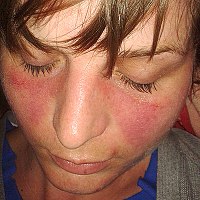
Photo from wikipedia
Alopecia areata and novel biologic agents: report of four cases and future directions Dear Editor, Alopecia areata (AA) is a chronic immune-mediated condition with a still unknown pathogenesis, although genetics… Click to show full abstract
Alopecia areata and novel biologic agents: report of four cases and future directions Dear Editor, Alopecia areata (AA) is a chronic immune-mediated condition with a still unknown pathogenesis, although genetics and environmental triggers have been implicated thus far. Proinflammatory cytokines such as tumor necrosis factor-alpha (TNF-a) and interferon-gamma (INF-c) are thought to induce immune system activation against the hair follicle. In the last few years, several biologic drugs, especially TNF blockers, have demonstrated efficacy in a variety of immune-mediated inflammatory diseases (IMIDs) including AA. However, cases of AA and alterations in the immune system during these therapies have been recently described. We report herein four cases of AA occurring during treatment with different biologic drugs for IMIDs and discuss future directions on this novel therapy. Patients followed in the last 4 years at Hospital das Cl ınicas of Sao Paulo, Brazil, were included in this study. We selected four patients (two females: 34 and 67 years; and two males: 14 and 39 years), each one presenting with different IMIDs (psoriatic arthritis/psoriasis, rheumatoid arthritis, juvenile rheumatoid arthritis/atopic dermatitis (DA), and systemic lupus erythematosus) who developed AA lesions during the treatment with TNF blockers adalimumab (n = 1), golimumab (n = 1), etanercept (n = 1), and a B-cell targeting agent, belimumab (n = 1), respectively. The diagnosis of AA was based on clinical, trichoscopic, and histopathological features. None of them had previous personal or familial history of AA or history of triggering factors such as stress, infection, or trauma before the onset of the lesions. Clinically, AA totalis (n = 2) and patchy AA (n = 2) were noted (Fig. 1). All three cases using anti-TNF-a agents developed AA lesions 28 (12–48) months after therapy. The most recent AA onset occurred 3 days after the first injection of belimumab. The patient receiving adalimumab had been previously treated with etanercept without developing AA. Therapy with anti-TNF-a drugs was maintained while B-cell drug was withdrawn for 1 month and then restarted. There was a
Journal Title: International Journal of Dermatology
Year Published: 2021
Link to full text (if available)
Share on Social Media: Sign Up to like & get
recommendations!